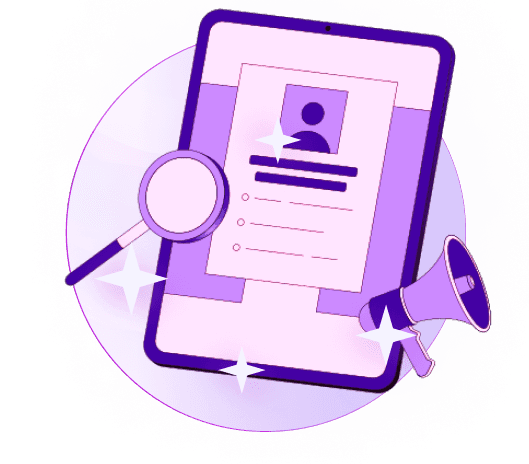Blogs
Articles

How to Generate Sales Qualified Leads: A Step-by-Step Guide for B2B Teams
Sales reps spend just 28% of their week selling. The rest of their time goes to administrative tasks and chasing leads that might never convert.
B2B teams can hit or miss their quota based on how they qualify leads for sales. A well-laid-out lead qualification process helps you identify serious buyers quickly. This approach optimizes revenue generation and sales performance.
We'll walk you through the exact steps to identify, qualify, and convert more sales qualified leads for your B2B organization in this piece. Let's head over to the details!
Why are sales-qualified leads important?
Sales qualified leads can completely change your business results. Companies that focus on lead quality close deals at rates up to 40%. This is a huge jump from the 11% success rate with unqualified leads. These numbers tell a clear story about your profits, sales efficiency, and team spirit.
B2B teams get multiple benefits from high-quality SQLs. Your team can use their time better by focusing on prospects who are ready to buy. They don't waste effort on leads that might never convert. This targeted strategy helps close deals faster and reduces the cost of getting new customers.
The money speaks for itself. Companies see better conversion rates when their sales and marketing teams work together on SQLs. CEOs and CFOs care about real business results, not just fancy numbers. That's why almost half of B2B marketers now focus their reports on valuable metrics like SQLs and Customer Lifetime Value.
What is a sales leader qualification?
Sales qualification serves as the foundation of a successful B2B sales process. Sales teams use this method to evaluate potential leads against specific criteria. This helps them identify prospects most likely to become customers.
Sales teams use qualification as a filter to focus on prospects with the best conversion potential. A reliable qualification framework helps teams become more productive. It saves time, boosts conversion rates, and maximizes ROI.
Sales qualification looks at these critical factors:
Fit criteria: Your offerings should match the prospect's needs
Budget considerations: The prospect must have money to invest in your solution
Authority: You need to know who makes decisions in the prospect's organization
Timeline: The prospect's urgency and decision timeline matter
Pain points: Your product should solve their challenges
Qualification gives teams useful information about customer needs, challenges, and goals. This knowledge helps create more targeted sales approaches.
What is a MQL and SQL?
The difference between MQLs and SQLs is vital for effective lead management. Let me break down these concepts for your B2B team.
A Marketing Qualified Lead (MQL) represents a potential customer who shows interest in your products or services through marketing activities. These leads interact with your content by visiting websites, downloading resources, opening emails, or engaging on social media. They're still exploring options and aren't ready to make a purchase decision yet.
A Sales Qualified Lead (SQL) shows a stronger buying intent and meets specific criteria that indicates higher conversion potential. These leads have moved past the original interest phase and want to talk to your sales team.
The Difference Between an MQL and SQL
The main difference between these lead types comes down to buying intent. Here are the key differences:
Stage in experience: MQLs research their options while SQLs actively look at purchase choices
Content engagement: MQLs read educational content like industry reports and general guides. SQLs focus on bottom-funnel materials such as pricing pages, product demos, and implementation docs
Readiness for sales: MQLs need more nurturing. SQLs welcome sales conversations
Conversion likelihood: Gartner's research reveals only 21% of MQLs become SQLs
Only 4% of potential buyers are in-market at any time. This makes it important to identify lead types correctly for resource allocation. MQLs might download an industry trends ebook. SQLs typically ask for product demos or pricing details.
This knowledge helps sales teams avoid reaching out too early to prospects who aren't ready. You can create better nurturing strategies for MQLs until they show signs of becoming sales-ready leads.
How Do organizations Identify SQLs?
B2B companies that succeed know how to identify sales qualified leads through careful evaluation. Companies with a well-laid-out lead qualification process see 50% more sales-ready leads and up to a 28% boost in conversions.
Organizations of all sizes rely on time-tested frameworks to identify their SQLs. The BANT methodology (Budget, Authority, Need, Timeline) helps sales teams evaluate four significant elements:
Budget availability - The prospect's financial resources allocated to your solution
Authority - The decision-maker's role or influence in purchasing decisions
Need - A genuine problem your product can solve
Timeline - The prospect's planned purchase timeline
Sales teams also use other frameworks like CHAMP (Challenges, Authority, Money, Prioritization), ANUM (Authority, Need, Urgency, Money), or MEDDIC for complex enterprise sales.
SQL identification requires evaluating engagement patterns through multiple channels. Sales teams look at website visits, content downloads, and social media activity to measure interest levels. They typically assess:
Interest shown in your offerings
Match with your ideal customer profile
Decision-making authority
Budget availability
Purchase timeline
Setting Up Your Lead Qualification Criteria
B2B sales processes succeed when proper lead qualification criteria are in place. A good qualification system helps identify prospects who are likely to become valuable customers and saves time and resources.
Define your ideal customer profile
The life-blood of lead qualification starts with a clear outline of your ideal customer profile (ICP). Your documentation should include specific traits of leads that typically become successful, long-term customers. These traits cover industry, company size, role, and specific pain points your solution addresses.
Kenny Powell, Sr. ADR at UserGems, shares his perspective: "The first step is to have a solid understanding of your ICP. You need to know who buys from you, why they buy, and what foundation it takes for those who do buy to be successful". Your ICP should go beyond simple firmographics to identify pain points, motivations, and roles that match your offering.
Establish behavioral and demographic signals
A scoring system that combines demographic and behavioral signals works best. Demographic scoring reviews static attributes like job titles and company size. Behavioral scoring tracks engagement patterns such as website visits, content downloads, and email interactions.
First-party data from your channels helps learn about prospect engagement levels. This data combined with third-party information provides broader market context. Research indicates that a balanced approach yields the best results—combining quantitative factors like budget with qualitative insights about specific pain points.
Arrange marketing and sales on SQL definitions
Marketing and sales teams must share similar definitions of qualified leads. Research shows that only 44% of companies have formal agreements on lead qualification criteria between departments. This gap creates inefficiency and missed opportunities.
Clear handoff processes between teams need documented frameworks. Service level agreements (SLAs) for the lead transfer process ensure high-value prospects get proper attention.
Want to improve your lead qualification and generate more SQLs? Check out Persana.ai to utilize AI-powered solutions that identify promising prospects through intelligent data analysis.
How to Qualify Leads Step-by-Step
Lead qualification needs systematic processes that help teams focus on prospects who might actually buy. Here are some practical ways to qualify leads quickly.
Use lead scoring models effectively
Lead scoring changes qualification from guesswork to science. Your team should assign points to prospect behaviors and attributes that show purchase readiness. Actions like visiting pricing pages, attending webinars, or downloading case studies deserve higher scores. The system should also use negative scoring when prospects show disinterest by browsing career pages.
Companies with good lead scoring models report a 25% increase in conversion rates. Teams should check their scoring system against actual conversions and adjust thresholds to work better.
Ask the right qualifying questions
Smart qualification questions can boost lead-to-opportunity conversion rates by 35%. The best approach uses open-ended questions that show real buying intent:
"What business problem are you trying to solve with our solution?"
"What is your timeline for implementing a solution?"
"Who else is involved in the decision-making process?"
"What is your budget for finding a solution?"
Sales teams should record these responses in their CRM to build better lead profiles and keep the qualification process consistent.
Track engagement and buying intent
Real buying intent looks different from casual interest. Serious prospects view product pages instead of blog content, interact more often, and connect through multiple channels.
Marketing automation platforms should track these behaviors systematically to spot patterns that associate with successful conversions.
Use CRM tools to manage lead data
Modern CRM systems work as central hubs for prospect information. Teams can reach out personally without hunting for data manually. These systems track activities like emails and calls automatically while showing each lead's complete history.
CRMs with AI can analyze patterns and spot which leads need immediate attention. This feature improves sales efficiency by up to 40%.
Teams looking for advanced lead qualification should check out tools like Persana.ai that use smart algorithms to find promising prospects.
Conclusion
Quality sales qualified leads are the life-blood of successful B2B sales operations. As I wrote in this piece, proper lead qualification revolutionizes sales efficiency and business performance.
Companies that prioritize quality over quantity achieve closing ratios almost four times higher than those chasing unqualified leads. This impacts your bottom line, team morale, and resource allocation. The structured qualification frameworks like BANT, CHAMP, ANUM, and MEDDIC offer proven ways to identify genuine buying intent.
Sales and marketing arrangement is a vital factor for SQL success. Teams that share similar definitions of qualified leads see up to 20% more sales opportunities. This collaboration needs formalized processes with clear handoff procedures, not just casual agreement.
Lead qualification must stay dynamic. Regular reviews of your criteria against actual conversion data help refine your approach. The market evolves, buyer behaviors change, and your qualification process should adapt.

Create Your Free Persana Account Today
Join 5000+ GTM leaders who are using Persana for their outbound needs.
How Persana increases your sales results
One of the most effective ways to ensure sales cycle consistency is by using AI-driven automation. A solution like Persana, and its AI SDR - Nia, helps you streamline significant parts of your sales process, including prospecting, outreach personalization, and follow-up.



